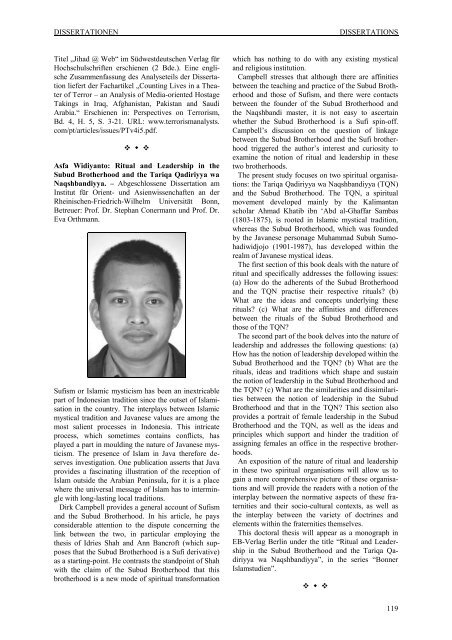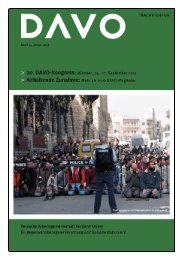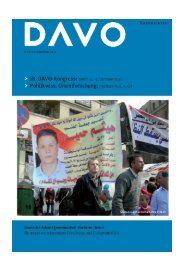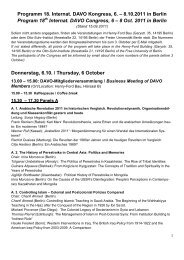4 Dissertationen und Habilita- tionen / Dissertations and Habilitations
4 Dissertationen und Habilita- tionen / Dissertations and Habilitations
4 Dissertationen und Habilita- tionen / Dissertations and Habilitations
Erfolgreiche ePaper selbst erstellen
Machen Sie aus Ihren PDF Publikationen ein blätterbares Flipbook mit unserer einzigartigen Google optimierten e-Paper Software.
DISSERTATIONEN DISSERTATIONS<br />
Titel „Jihad @ Web“ im Südwestdeutschen Verlag für<br />
Hochschulschriften erschienen (2 Bde.). Eine englische<br />
Zusammenfassung des Analyseteils der Dissertation<br />
liefert der Fachartikel „Counting Lives in a Theater<br />
of Terror – an Analysis of Media-oriented Hostage<br />
Takings in Iraq, Afghanistan, Pakistan <strong>and</strong> Saudi<br />
Arabia.“ Erschienen in: Perspectives on Terrorism,<br />
Bd. 4, H. 5, S. 3-21. URL: www.terrorismanalysts.<br />
com/pt/articles/issues/PTv4i5.pdf.<br />
� � �<br />
Asfa Widiyanto: Ritual <strong>and</strong> Leadership in the<br />
Subud Brotherhood <strong>and</strong> the Tariqa Qadiriyya wa<br />
Naqshb<strong>and</strong>iyya. – Abgeschlossene Dissertation am<br />
Institut für Orient- <strong>und</strong> Asienwissenchaften an der<br />
Rheinischen-Friedrich-Wilhelm Universität Bonn,<br />
Betreuer: Prof. Dr. Stephan Conermann <strong>und</strong> Prof. Dr.<br />
Eva Orthmann.<br />
Sufism or Islamic mysticism has been an inextricable<br />
part of Indonesian tradition since the outset of Islamisation<br />
in the country. The interplays between Islamic<br />
mystical tradition <strong>and</strong> Javanese values are among the<br />
most salient processes in Indonesia. This intricate<br />
process, which sometimes contains conflicts, has<br />
played a part in moulding the nature of Javanese mysticism.<br />
The presence of Islam in Java therefore deserves<br />
investigation. One publication asserts that Java<br />
provides a fascinating illustration of the reception of<br />
Islam outside the Arabian Peninsula, for it is a place<br />
where the universal message of Islam has to intermingle<br />
with long-lasting local traditions.<br />
Dirk Campbell provides a general account of Sufism<br />
<strong>and</strong> the Subud Brotherhood. In his article, he pays<br />
considerable attention to the dispute concerning the<br />
link between the two, in particular employing the<br />
thesis of Idries Shah <strong>and</strong> Ann Bancroft (which supposes<br />
that the Subud Brotherhood is a Sufi derivative)<br />
as a starting-point. He contrasts the st<strong>and</strong>point of Shah<br />
with the claim of the Subud Brotherhood that this<br />
brotherhood is a new mode of spiritual transformation<br />
which has nothing to do with any existing mystical<br />
<strong>and</strong> religious institution.<br />
Campbell stresses that although there are affinities<br />
between the teaching <strong>and</strong> practice of the Subud Brotherhood<br />
<strong>and</strong> those of Sufism, <strong>and</strong> there were contacts<br />
between the fo<strong>und</strong>er of the Subud Brotherhood <strong>and</strong><br />
the Naqshb<strong>and</strong>i master, it is not easy to ascertain<br />
whether the Subud Brotherhood is a Sufi spin-off.<br />
Campbell’s discussion on the question of linkage<br />
between the Subud Brotherhood <strong>and</strong> the Sufi brotherhood<br />
triggered the author’s interest <strong>and</strong> curiosity to<br />
examine the notion of ritual <strong>and</strong> leadership in these<br />
two brotherhoods.<br />
The present study focuses on two spiritual organisations:<br />
the Tariqa Qadiriyya wa Naqshb<strong>and</strong>iyya (TQN)<br />
<strong>and</strong> the Subud Brotherhood. The TQN, a spiritual<br />
movement developed mainly by the Kalimantan<br />
scholar Ahmad Khatib ibn ‘Abd al-Ghaffar Sambas<br />
(1803-1875), is rooted in Islamic mystical tradition,<br />
whereas the Subud Brotherhood, which was fo<strong>und</strong>ed<br />
by the Javanese personage Muhammad Subuh Sumohadiwidjojo<br />
(1901-1987), has developed within the<br />
realm of Javanese mystical ideas.<br />
The first section of this book deals with the nature of<br />
ritual <strong>and</strong> specifically addresses the following issues:<br />
(a) How do the adherents of the Subud Brotherhood<br />
<strong>and</strong> the TQN practise their respective rituals? (b)<br />
What are the ideas <strong>and</strong> concepts <strong>und</strong>erlying these<br />
rituals? (c) What are the affinities <strong>and</strong> differences<br />
between the rituals of the Subud Brotherhood <strong>and</strong><br />
those of the TQN?<br />
The second part of the book delves into the nature of<br />
leadership <strong>and</strong> addresses the following questions: (a)<br />
How has the notion of leadership developed within the<br />
Subud Brotherhood <strong>and</strong> the TQN? (b) What are the<br />
rituals, ideas <strong>and</strong> traditions which shape <strong>and</strong> sustain<br />
the notion of leadership in the Subud Brotherhood <strong>and</strong><br />
the TQN? (c) What are the similarities <strong>and</strong> dissimilarities<br />
between the notion of leadership in the Subud<br />
Brotherhood <strong>and</strong> that in the TQN? This section also<br />
provides a portrait of female leadership in the Subud<br />
Brotherhood <strong>and</strong> the TQN, as well as the ideas <strong>and</strong><br />
principles which support <strong>and</strong> hinder the tradition of<br />
assigning females an office in the respective brotherhoods.<br />
An exposition of the nature of ritual <strong>and</strong> leadership<br />
in these two spiritual organisations will allow us to<br />
gain a more comprehensive picture of these organisations<br />
<strong>and</strong> will provide the readers with a notion of the<br />
interplay between the normative aspects of these fraternities<br />
<strong>and</strong> their socio-cultural contexts, as well as<br />
the interplay between the variety of doctrines <strong>and</strong><br />
elements within the fraternities themselves.<br />
This doctoral thesis will appear as a monograph in<br />
EB-Verlag Berlin <strong>und</strong>er the title “Ritual <strong>and</strong> Leadership<br />
in the Subud Brotherhood <strong>and</strong> the Tariqa Qadiriyya<br />
wa Naqshb<strong>and</strong>iyya”, in the series “Bonner<br />
Islamstudien”.<br />
� � �<br />
119





